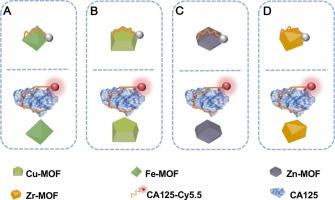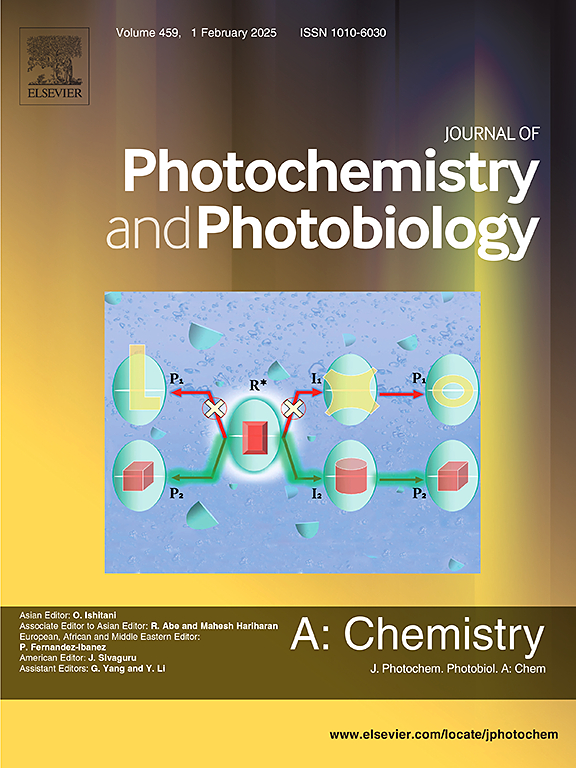Metal organic frameworks (MOFs)-based fluorescent CA125 analysis: A comparative study of the quenching effects of MIL-101, Cu-MOF, ZIF-8, UiO-66
IF 4.1
3区 化学
Q2 CHEMISTRY, PHYSICAL
Journal of Photochemistry and Photobiology A-chemistry
Pub Date : 2024-10-19
DOI:10.1016/j.jphotochem.2024.116098
引用次数: 0
Abstract
Metal-organic frameworks (MOFs) are a class of materials with highly ordered pore structures. Due to their unique physical and chemical properties, they show great potential in the field of biosensors. Some MOFs can adsorb fluorescently labeled nucleic acid aptamers through various interaction mechanisms (such as electrostatic interactions, π-π stacking, hydrogen bonding, etc.). These interactions not only ensure the stable binding of the aptamers but also allow for their controlled release under specific conditions (such as changes in pH, temperature, or the presence of specific molecules). This mechanism provides multiple possibilities for the design of biosensors. Herein, we have systematically compared the quenching effects of widely used MOFs that can bind to aptamers, i.e., Fe-MOF (MIL-101), Cu-MOF, Zn-MOF (ZIF-8) and Zr-MOF (UiO-66). The study on the kinetics, quenching efficiency, and influencing factors such as ionic strength pH and temperature is performed. Interestingly, Cu-MOF exhibits superior quenching abilities to the other three materials in both the quenching efficiency and kinetics. Thus, a Cu-MOF based fluorescent sensor is reported to detect the ovarian cancer marker carbohydrate antigen 125 (CA125), which provides convenient detection performance (assay time about 10 min), and a detection range from 0.1 to 400 ng/mL. Moreover, it is designed in a simple mix-and-detect format and can be directly applied to clinical sample detection. This work may offer guidance for the choice of MOFs and elaborate design of biosensors.

基于金属有机框架(MOFs)的荧光 CA125 分析:MIL-101、Cu-MOF、ZIF-8 和 UiO-66 的淬灭效应比较研究
金属有机框架(MOFs)是一类具有高度有序孔隙结构的材料。由于其独特的物理和化学特性,它们在生物传感器领域显示出巨大的潜力。一些 MOFs 可通过各种相互作用机制(如静电作用、π-π 堆积、氢键等)吸附荧光标记的核酸适配体。这些相互作用不仅能确保适配体的稳定结合,还能在特定条件下(如 pH 值、温度的变化或特定分子的存在)控制其释放。这种机制为生物传感器的设计提供了多种可能性。在此,我们系统地比较了广泛使用的可与aptamers结合的MOFs(即Fe-MOF (MIL-101)、Cu-MOF、Zn-MOF (ZIF-8)和Zr-MOF (UiO-66))的淬灭效应。对动力学、淬火效率以及离子强度、pH 值和温度等影响因素进行了研究。有趣的是,Cu-MOF 在淬灭效率和动力学方面的淬灭能力都优于其他三种材料。因此,本研究报告了一种基于 Cu-MOF 的荧光传感器,用于检测卵巢癌标志物碳水化合物抗原 125(CA125),其检测性能方便(检测时间约为 10 分钟),检测范围为 0.1 至 400 ng/mL。此外,该试剂盒设计为简单的混合检测形式,可直接应用于临床样本检测。这项工作可为选择 MOFs 和精心设计生物传感器提供指导。
本文章由计算机程序翻译,如有差异,请以英文原文为准。
求助全文
约1分钟内获得全文
求助全文
来源期刊
CiteScore
7.90
自引率
7.00%
发文量
580
审稿时长
48 days
期刊介绍:
JPPA publishes the results of fundamental studies on all aspects of chemical phenomena induced by interactions between light and molecules/matter of all kinds.
All systems capable of being described at the molecular or integrated multimolecular level are appropriate for the journal. This includes all molecular chemical species as well as biomolecular, supramolecular, polymer and other macromolecular systems, as well as solid state photochemistry. In addition, the journal publishes studies of semiconductor and other photoactive organic and inorganic materials, photocatalysis (organic, inorganic, supramolecular and superconductor).
The scope includes condensed and gas phase photochemistry, as well as synchrotron radiation chemistry. A broad range of processes and techniques in photochemistry are covered such as light induced energy, electron and proton transfer; nonlinear photochemical behavior; mechanistic investigation of photochemical reactions and identification of the products of photochemical reactions; quantum yield determinations and measurements of rate constants for primary and secondary photochemical processes; steady-state and time-resolved emission, ultrafast spectroscopic methods, single molecule spectroscopy, time resolved X-ray diffraction, luminescence microscopy, and scattering spectroscopy applied to photochemistry. Papers in emerging and applied areas such as luminescent sensors, electroluminescence, solar energy conversion, atmospheric photochemistry, environmental remediation, and related photocatalytic chemistry are also welcome.

 求助内容:
求助内容: 应助结果提醒方式:
应助结果提醒方式:


